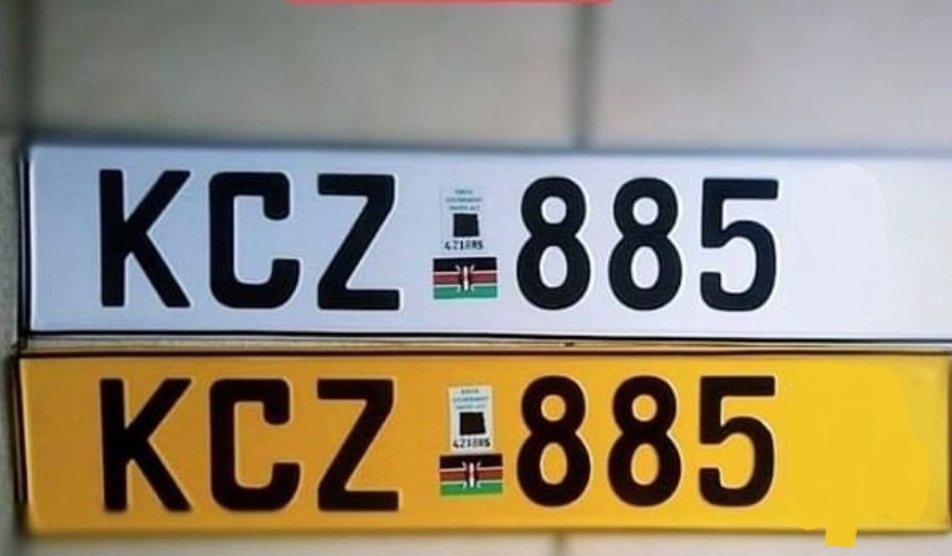In Kenya, vehicle number plates are more than just identifiers—they are a legal requirement that ensures compliance with road safety regulations and enhances vehicle security. With the introduction of new-generation digital number plates in 2022, the National Transport and Safety Authority (NTSA) has transformed the process of obtaining and replacing number plates, making it more efficient through the eCitizen platform. Whether you’re registering a new vehicle, replacing lost or damaged plates, or upgrading to the new reflective plates, understanding the costs, requirements, and procedures is essential for Kenyan motorists and dealers. This comprehensive guide dives into the charges for getting and replacing number plates in Kenya, the step-by-step application process, timelines, and practical tips to ensure a seamless experience, tailored to the Kenyan context.
The Role of Number Plates in Kenya’s Transport System
Number plates in Kenya serve as a critical tool for vehicle identification, ownership verification, and law enforcement. Managed by the NTSA under the Traffic Act, number plates help combat vehicle theft, fraud, and tax evasion. The introduction of new-generation reflective number plates in August 2022, launched by then-Interior Cabinet Secretary Fred Matiang’i, marked a significant upgrade. These plates feature advanced security elements like microchips, holograms, and unique serial numbers linked to the vehicle’s chassis, enhancing traceability and reducing cloning risks.
For Kenyan motorists, whether driving a private car, motorcycle, or public service vehicle (PSV), obtaining or replacing number plates is a mandatory step to stay compliant. This article outlines the costs, requirements, and processes for both new and replacement number plates, with a focus on the latest regulations as of 2025.
Why Number Plates Matter
Number plates are integral to Kenya’s transport ecosystem for several reasons:
- Legal Compliance: Driving without proper number plates violates Section 12(1) of the Traffic Act, leading to fines of Ksh 1,000 or vehicle impoundment.
- Vehicle Security: New-generation plates with microchips and QR codes make it harder to forge or steal vehicles.
- Tax Verification: Plates are synchronized with KRA systems to ensure import duties and taxes are paid, especially for imported vehicles.
- Road Safety: Reflective plates improve visibility at night, reducing accidents and aiding law enforcement.
With over 1 million vehicles expected to transition to new-generation plates by 2025, understanding the associated costs and processes is crucial for compliance.
Charges for Getting New Number Plates in Kenya
The cost of obtaining new number plates in Kenya varies depending on the vehicle type, plate type, and whether the vehicle is newly registered or imported. Below is a detailed breakdown of the charges as of 2025, based on NTSA guidelines:
Standard Number Plates
- Motor Vehicles: Ksh 3,050 (includes a pair of reflective plates and a Ksh 50 service fee).
- Motorcycles: Ksh 1,550 (includes a single reflective plate).
- E-Sticker: Ksh 700 (mandatory for all vehicles, placed on the windscreen to confirm ownership and vehicle details).
Preferred/Special Number Plates
- Cost: Ksh 30,000 for personalized plates with specific numbers or letters (e.g., unique combinations, subject to NTSA approval).
Customized Number Plates
- Cost: Ksh 1,000,000 for fully customized plates, with an annual maintenance fee of Ksh 50,000.
- Note: These are typically used by high-profile individuals or businesses and require special authorization.
Additional Fees for New Registrations
For newly registered vehicles, additional costs may apply:
- Inspection Fee: Ksh 1,750 for vehicle inspection and e-sticker issuance.
- Transfer Fees (for locally purchased used vehicles): Vary by engine capacity:
- Up to 1,000cc: Ksh 1,660–2,000.
- 1,001–1,200cc: Ksh 1,890–2,500.
- 1,201–1,500cc: Ksh 2,065–3,000.
- Import-Related Fees (for imported vehicles):
- Port charges: Approx. Ksh 12,000.
- Verification and Interpol fees: Ksh 30,000 combined.
- Import Declaration Form (IDF) fee: Ksh 2,000.
Note: Fees are subject to change. Always verify the latest charges on the NTSA website (www.ntsa.go.ke) or eCitizen portal.
Charges for Replacing Lost or Damaged Number Plates
Replacing lost or damaged number plates follows a different process and cost structure:
- Single Reflective Number Plate: Ksh 1,550 (for front or rear plate).
- Pair of Reflective Number Plates: Ksh 3,050.
- Customized Number Plate Replacement: Ksh 50,000.
- E-Sticker Replacement: Ksh 700, if damaged or missing.
- Additional Requirements:
- Police Abstract: Free, but required to report loss or damage.
- Tape Lifting Report: Obtained from DCI offices to verify chassis and engine numbers (cost varies, typically Ksh 500–1,000).
- Affidavit: From a Commissioner of Oaths for lost plates (approx. Ksh 500).
Note: Failure to replace lost or damaged plates promptly can lead to fines or legal action under the Traffic Act.
Step-by-Step Process for Getting New Number Plates
The process for obtaining new number plates, whether for newly registered vehicles or as part of the mandatory transition to new-generation plates, is streamlined through the eCitizen portal. Below is a step-by-step guide:
1. Gather Required Documents
For new registrations or transitions to new-generation plates, prepare the following:
- Original Logbook: Proof of vehicle ownership.
- National ID or Passport: For the vehicle owner or authorized agent.
- KRA PIN Certificate: For tax verification.
- Customs Documents (for imported vehicles): Include Import Declaration Form, bill of lading, and KEBS certificate.
- Photos of Current Plates (for transitions): Scanned in PDF format.
- Colored Copy of Logbook: Combined with other documents in a single PDF.
2. Access the eCitizen Portal
- Visit accounts.ecitizen.go.ke and log in using your ID number and password.
- If you don’t have an account, create one with your National ID, KRA PIN, and contact details.
- Navigate to the “National Transport and Safety Authority (NTSA) (New)” section.
- Select the TIMS service portal and complete two-factor authentication.
3. Apply for New Number Plates
- In the TIMS portal, select “Vehicle Registration” and click “Apply for Reflective Plate.”
- Choose the vehicle type (motor vehicle or motorcycle) and select “New Generation Plate” as the reason for application.
- Input vehicle details: registration number, chassis number, and engine number.
- Select plate shape: Square or oblong, depending on the vehicle’s design.
- Upload required documents in a single PDF.
- Specify the collection center (e.g., NTSA offices in Nairobi, Mombasa, or Kisumu).
- Provide the ID and name of the authorized person to collect the plates.
4. Make Payment
- Pay Ksh 3,050 for motor vehicles or Ksh 1,550 for motorcycles via M-Pesa, card, or bank transfer.
- For preferred plates, pay Ksh 30,000; for customized plates, pay Ksh 1,000,000.
- Download the e-sticker after payment confirmation.
5. Await Processing and Collection
- Processing takes 7 working days, with an SMS notification sent when plates are ready.
- Bring your original ID, old plates (if transitioning), and logbook to the designated NTSA collection center.
- Have plates installed by an authorized vendor to meet regulatory standards.
Step-by-Step Process for Replacing Lost or Damaged Number Plates
Replacing lost or damaged plates requires additional steps to verify the vehicle’s legitimacy:
1. Report the Loss or Damage
- Visit a police station to report the loss or damage and obtain a police abstract (free).
- Visit DCI offices with the original logbook and police abstract to get a tape lifting report verifying the chassis and engine numbers.
- Obtain an affidavit from a Commissioner of Oaths for lost plates.
2. Prepare Documents
- Original logbook.
- National ID or passport.
- KRA PIN certificate.
- Police abstract.
- Tape lifting report.
- Affidavit (for lost plates).
- Photos of damaged plates (if applicable), combined in a single PDF.
3. Access the TIMS Portal
- Log in to the eCitizen portal and navigate to the NTSA section.
- Select “Vehicle Registration” and choose “Apply for Reflective Plate.”
- Indicate whether the plate is “Lost” or “Defaced.”
- Select the plate type (single or pair) and shape (square or oblong).
4. Submit Application and Pay
- Upload documents in PDF format.
- Specify the collection center and authorized collector’s details.
- Pay Ksh 1,550 for a single plate or Ksh 3,050 for a pair.
- Confirm payment and download the e-sticker.
5. Collect Replacement Plates
- Wait 7 working days for processing.
- Collect plates at the designated NTSA center with your ID, logbook, and old plates (if defaced).
- Ensure installation by an authorized vendor.
Timelines for Number Plate Issuance
- New Number Plates: Processed within 7 working days after application approval.
- Replacement Plates: Also processed within 7 working days, provided all documents are complete.
- Logbook Issuance: For new registrations, logbooks are issued within 3 working days.
Note: Delays may occur due to incomplete documentation, system congestion, or unpaid fees. Check the eCitizen portal regularly for updates.
Tips for a Smooth Number Plate Application Process
To ensure a hassle-free experience, follow these practical tips:
- Verify Documents: Ensure all scans are clear, in color, and combined into a single PDF. Double-check chassis and engine numbers.
- Stable Internet Connection: Use a reliable connection to avoid errors during submission on the eCitizen portal.
- Engage a Clearing Agent: For imported vehicles, a licensed agent can streamline customs and NTSA processes.
- Check Application Status: Monitor the eCitizen portal or SMS notifications for updates.
- Collect Promptly: Respond to NTSA notifications to avoid backlogs at collection centers.
- Authorized Installation: Use NTSA-approved vendors to install plates to meet regulatory standards.
- Stay Updated: Check www.ntsa.go.ke for the latest fee schedules and deadlines, as regulations may change.
For Dealers:
- Train staff on TIMS navigation for bulk applications.
- Verify customer documents (e.g., KRA PIN, ID) before submission.
- Monitor NTSA updates for proposed fee changes, such as the 2023 suggestion to increase standard plate fees to Ksh 5,000.
Common Challenges and Solutions
Despite the streamlined process, challenges may arise:
- Document Rejections: Incomplete or unclear scans lead to rejections. Solution: Use high-quality scans and verify all details before submission.
- System Downtime: The eCitizen portal may face technical issues. Solution: Apply during off-peak hours or contact NTSA support via info@ntsa.go.ke.
- Payment Delays: Mobile money transactions may take time to reflect. Solution: Confirm payment status before completing the application.
- Shortages of Plates: Periodic shortages, as seen in 2024, can delay issuance. Solution: Apply early and collect plates promptly upon notification.
For unresolved issues, visit an NTSA office or use the NTSA mobile app for support.
Additional Legal Requirements
Beyond number plates, vehicle owners must meet other legal obligations:
- Third-Party Insurance: Mandatory for all vehicles to cover liabilities in accidents.
- Smart Driving License: Required for the appropriate vehicle class (e.g., Class B for private vehicles).
- Vehicle Inspection: Mandatory for imported used vehicles or those with modifications.
- Compliance with Deadlines: Transition to new-generation plates by August 29, 2025, to avoid fines or impoundment, especially for government vehicles.
Special Considerations for New-Generation Plates
The new-generation plates, mandatory since 2022, offer enhanced security and visibility:
- Features: Include a Kenyan flag, hologram of the Big Five animals, QR code, microchip, and unique serial numbers linked to the chassis.
- Mandatory Transition: All vehicles must switch by August 29, 2025, with non-compliance risking fines or impoundment.
- Imported Vehicles: New plates are fixed at the point of entry, synchronized with NTSA and KRA systems to curb tax evasion.
Note: Old plates are still valid for logbook loans, but upgrading to new plates can enhance credibility and reduce fraud risks.
Obtaining or replacing number plates in Kenya is a straightforward process when using the NTSA’s TIMS portal via eCitizen. With standard plates costing Ksh 3,050 for motor vehicles and Ksh 1,550 for motorcycles, and replacements ranging from Ksh 1,550 to Ksh 50,000 for customized plates, understanding the charges and requirements is key to compliance. The new-generation reflective plates, with their advanced security features, are a significant step toward safer roads and reduced vehicle fraud. By preparing the necessary documents, following the outlined steps, and staying informed about NTSA regulations, Kenyan motorists and dealers can navigate the process efficiently. Start your application today at www.ntsa.go.ke or the eCitizen portal to ensure your vehicle is road-legal and secure.





